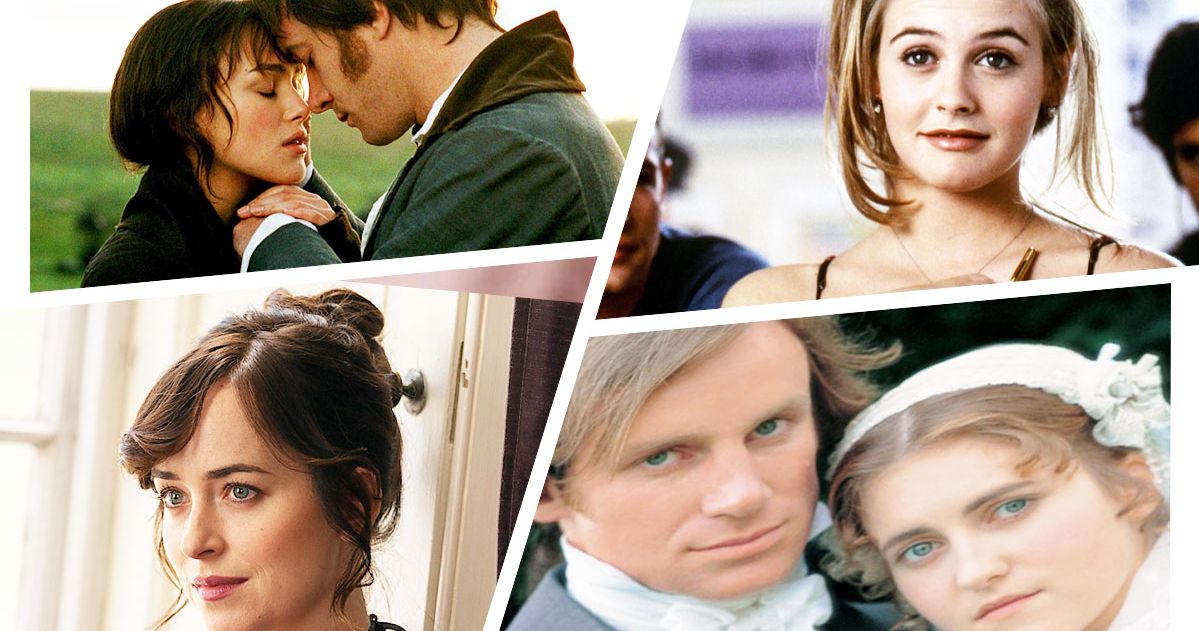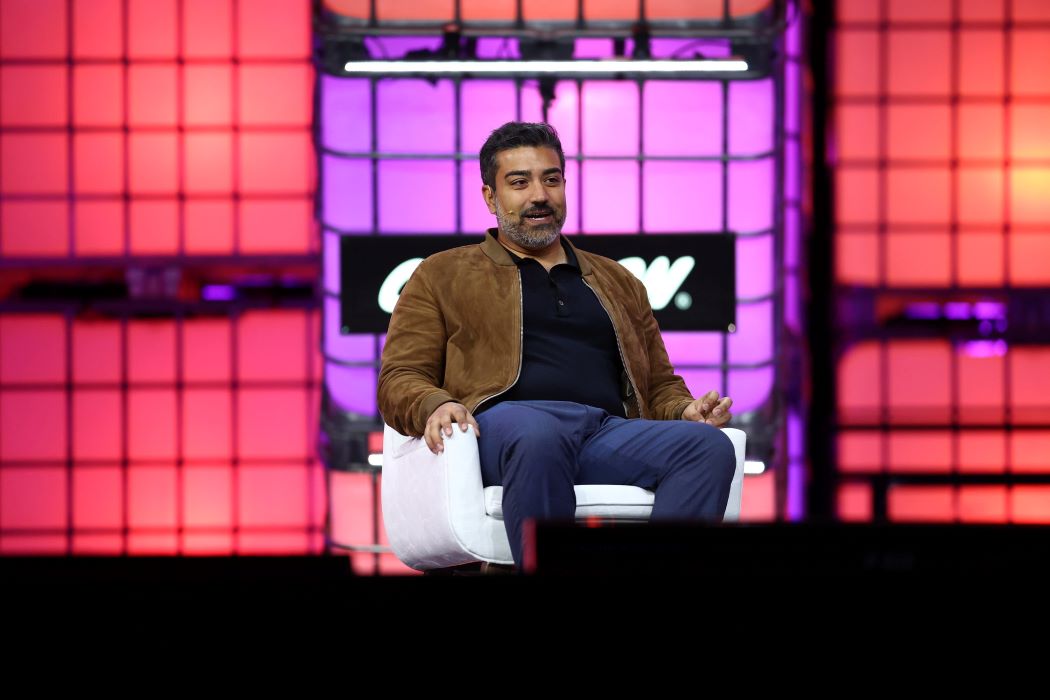
The Evolution of the Jane Austen Adaptation
It is a truth known to only me, but now universally, that I spent days trying to think of a clever, fresh way to start this piece about Jane Austen film and television adaptations with an “It is a truth universally acknowledged” bit, and in the end this is all I came up with, and for that I apologize.
Over the past several decades, Jane Austen, who wrote six novels before her death in 1817 at the age of 41, has essentially become the Lady Shakespeare. Her work is endlessly adapted in all sorts of ways; her stories and characters inspire many storytellers consciously and, sometimes, perhaps, subconsciously. Her influence, despite her comparatively tiny body of work, is palpable, especially in film and television. Austen perfected the will-they-or-won’t-they dynamic and the love-hate dynamic, and she opened up the world to the female experience in a society that forced them to be dependent on men. Austen’s ahead-of-her-time sensibility, themes, sharp criticism, characters, and fascination with the human condition translate seamlessly to the modern world and, therefore, storytelling onscreen.
Jane Austen screen adaptations started in 1938 with a television movie of Pride and Prejudice. In 1940, Pride and Prejudice was adapted for the big screen in a film starring Greer Garson as Elizabeth Bennett and Laurence Olivier as Mr. Darcy. Although the film was a critical and box-office success, Austen adaptations took a back seat — save for a TV adaptation here and there — until the 1970s. In the half-century since, Austen adaptations have developed into a genre all their own, with subgenres. As Hollywood changed, as filmmaking evolved, as movie stars came and went, the Austen adaptations have also changed and evolved. Adaptations and interpretations of Austen’s novels aren’t always a success, but they remain prevalent decades later thanks to her passion and ability to subvert societal norms within a romantic narrative. Here is a close look at the evolution of the Austen adaption in television and film throughout the decades until today.
’70s–’80s: Sundays on PBS
–>
Decades after the 1940s Pride & Prejudice, Jane Austen adaptations returned in the 1970s in the form of miniseries, most often for BBC and consumed by American audiences on PBS’s Masterpiece Theatre. Loyal to a fault, these are characterized by staying so true to the source material that, ironically, themes and characters get completely lost. In the stuffy Austen adaptations throughout the ’70s and ’80s, casts do not include any movie stars. They have a stage play feel, with flat sets, costume-y costumes, theater-trained British thespians, and a complete lack of any modern interpretations or themes. This is not to say they are bad, but the strict, romantic interpretation of the time period within Austen’s novels with no fresh or modern spin makes them feel dull in retrospect, especially when compared to the Austen adaptations to come.
Notable Adaptations: Sense and Sensibility (1971), Persuasion (1971), Emma (1972), Pride & Prejudice (1980), Sense and Sensibility (1981), Mansfield Park (1983), Northanger Abbey (1987).
Defining Adaptation: Mansfield Park (1983) is not one of Austen’s most popular works, so unlike Emma or Pride and Prejudice, there is not a new adaptation or interpretation of it every two years, which means there aren’t many Mansfield Park adaptations to choose from. While the miniseries feels very of this era in its undying loyalty to the source material, it is exactly that loyalty that makes it the most significant. That’s thanks to spot-on casting of its emotional and morally sound lead, Fanny Price, played by Sylvestra Le Touzel in a role I’m sure a very confused Lea Michele tried to steal.
’90s: Jane Austen Goes to Hollywood
–>
In the ’90s, Jane Austen adaptations gained popularity by way of the modern rom-com. This era introduces the Jane Austen adaptation to Hollywood, to comedy, and to movie stars. The comedic elements that already exist within Austen’s novels are exaggerated, and adaptations lean into various themes and experiment with tone, creating distinct adaptations that establish the Jane Austen adaptation as its own genre with other genres inside it, from romantic drama to dramedy to teen comedy. Emma Thompson’s Oscar-nominated screenplay for the Ang Lee–directed Sense and Sensibility, for example, took liberties with the story and adjusted certain characters to make the adaptation more suitable for the medium and more resonant for a modern audience. This era also introduces star performances in Austen adaptations, including Gwyneth Paltrow as Emma and, most significantly, Colin Firth’s defining role as Mr. Darcy. Both Paltrow and Firth went on to win Oscars.
Notable Adaptations: Metropolitan (1995), Sense and Sensibility (1995), Clueless (1995), Persuasion (1995), Pride and Prejudice (1995), Emma (1996), Jane Austen’s Emma (1996)*, Mansfield Park (1999).
*Yes, there were two Emma adaptations in 1996 following 1995’s Clueless, which was also an Emma adaptation. Emma stars Gwyneth Paltrow, and Jane Austen’s Emma stars Kate Beckinsale.
Defining Adaptation: Clueless (1995). Both a romantic comedy and a Jane Austen adaptation, Clueless represents the best a Jane Austen movie can be: funny, romantic, and biting. Clueless captures the true essence of Austen’s characters and stands the test of time because writer-director Amy Heckerling’s screenplay goes out of its way to adapt Austen-era themes into the ’90s, a feat that is successful as a result of Heckerling’s familiarity with the Austen source material. Clueless lets its flawed heroine be flawed and captures Austen’s gift for social satire by poking fun at her own characters and their world.
Photo: PBS
(I would be lying to myself and to you all if I did not also suggest that one of the best Austen adaptations of the ’90s is from an episode of the children’s television series Wishbone, which concisely adapts Pride & Prejudice within the confines of a 20-minute episode and stars Wishbone the dog as Mr. Darcy. Go off, king!)
2000s: Austen As Cinema
–>
In the early 2000s, Austen adaptations, while not nearly as prominent as they were in the ’90s, continued on a similar route. 2001’s Bridget Jones’ Diary, a raunchy reinterpretation of Pride and Prejudice based on the 1996 (peak Austen year) novel, expands what Clueless did in adapting Austen’s signature themes and classic characters in a purposefully current setting. In 2003, Pride and Prejudice: A Latter-Day Comedy takes the setting to a Mormon community in present-day Utah in (I didn’t make this up). It wasn’t until 2005 that everything changed with Joe Wright’s Pride & Prejudice starring Keira Knightley and Matthew Macfadyen. Wright shifted the time period from the early 1800s to the 1790s because he hates empire-waist dresses (correctly), and the film feels fresh and serious with inventive cinematography, a legendary soundtrack, and powerhouse performances. The rest of the decade ebbs and flows, with mostly derivative adaptations of already adapted novels, including a Sense & Sensibility miniseries starring Mamma Mia’s Dominic Cooper. None of the other adaptations of this era capture what Wright did — they don’t dare to try.
Notable Adaptations: Kandukondain Kandukondain (2000), Bridget Jones’ Diary (2001), Bride & Prejudice (2004), Bridget Jones: The Edge of Reason (2004), Pride & Prejudice (2005), Mansfield Park (2007), Northanger Abbey (2007), Persuasion (2007), Sense & Sensibility (2008), Emma (2009).
Defining Adaptation: Pride & Prejudice (2005). Joe Wright’s version of the novel that will never stop being adapted is the quintessential Austen adaptation, but more than that it is a stunning, singular piece of cinema on its own, from the horny hand flex to the sprawling landscapes to the performances from top (Knightley and Macfadyen) to bottom (Donald Sutherland and Brenda Blethyn). Wright’s film, more than any other Austen adaptation, focuses on the similarities between Austen’s world and ours, centuries later. Wright took Austen seriously and made it cinema.
2010s: Goodbye Jane
–>
The 2010s were where rom-coms went to die in favor of big budget superhero films and various IP that, unlike Jane Austen novels, didn’t need to be revisited. As the rom com got further and further buried under capes and spandex and piles of money, so did the mid-budget Austen adaptations, with a few exceptions. What we did get were things that are so 2010s they don’t even sound real, including the Sense and Sensibility–inspired From Prada to Nada starring Camilla Belle (bring her back!) and Alexa PenaVega, a web series based on Pride and Prejudice, and Pride and Prejudice and Zombies starring Mamma Mia Here We Go Again’s Lily James. Kate Beckinsale, one of the many Emmas of the ’90s, returned to Austen’s world alongside Chloë Sevigny in Love & Friendship, based on Austen’s epistolary novel Lady Susan.
Notable Adaptations: Aisha (2010), From Prada to Nada (2011), The Lizzie Bennet Diaries (2012–13), Pride and Prejudice and Zombies (2016), Love & Friendship (2016).
Defining Adaptation: Pride and Prejudice and Zombies (2016). I don’t have much to say about this one, but I have to give it credit for capitalizing off the success of The Walking Dead!
2020s: That’s The Truth, Jane
–>
We are only two years into the 2020s, but those two years have been decades. In those two decade-years (dears?), the Jane Austen adaptation has made a slow but welcome comeback and this time, Joe Wright’s Pride & Prejudice is finally influencing filmmakers to make Austen adaptations capital-C Cinema. Autumn de Wilde’s Emma starring Anya Taylor-Joy is charming, romantic, clever, and colorful, setting a promising precedent for the rest of the era. Fire Island adapts the oft-adapted Pride and Prejudice in the unexpected but very modern setting of Fire Island and the gay community. Meanwhile, in Netflix’s Persuasion, Dakota Johnson talks to a camera in a period setting while wearing clean-girl makeup with the same haircut she always has. She also uses extremely modern language, including “We’re worse than exes: We’re friends.” Did Tumblr write this screenplay?
Notable Adaptations: Emma (2020), Fire Island (2022), Persuasion (2022).
Defining Adaptation: Fire Island (2022). Joel Kim Booster’s rom-com proves how universal and versatile Austen’s work is. The nuanced script applies the events and characters of Pride and Prejudice into a completely different world, but the core of Austen’s most prolific work remains the same. Instead of satirizing 1800s British society, Fire Island satirizes modern gay society, using narrative clichés to its advantage, just as Austen does.
Related
- Is Jane Austen Just a Vibe Now?










































![iFi's GO Bar Kensei Dongle DAC Supports K2HD Technology With Some Samurai Swagger [Updated] iFi's GO Bar Kensei Dongle DAC Supports K2HD Technology With Some Samurai Swagger [Updated]](https://i0.wp.com/cdn.ecoustics.com/db0/wblob/17BA35E873D594/33FF/45A11/QTXOLJR4xDKSNMMk2WlTgjaIlvSgcYpeU1xJzUwIoYs/ifi-go-bar-kensei.jpg?w=768&ssl=1)
































